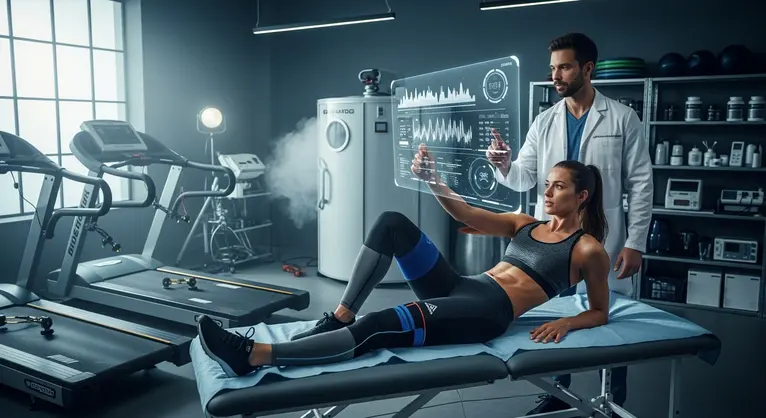Injuries are a roadblock no one wants. Whether you’re a weekend warrior, ambitious beginner, or seasoned athlete, knowing how to recover well—and avoid setbacks—can make or break your progress. But what if recovery could be smarter, safer, and personalized just for you? In this guide, we’ll explore how data-driven tools, nutrition, and mindset strategies are reshaping recovery and injury prevention for every fitness level.
Why Data Matters in Recovery
Traditionally, recovery meant rest and generic advice: “Take it easy,” or “just listen to your body.” But what if your body’s signals aren’t always clear? That’s where data comes in.
Real-World Example: Imagine returning to running after a calf strain. With a smart wearable, you monitor heart rate variability (HRV), sleep, and daily activity. On days when your HRV dips or you’re sleep-deprived, your device suggests an easier session—or a needed rest day. This isn’t guesswork; it’s personalized prevention.
Benefits of Data-Driven Recovery:
- Reduces guesswork by using real, individual metrics.
- Flags early signs of overload before pain strikes.
- Allows you to adjust intensity for safe, consistent progress.
Preventing Injuries Before They Happen
Injury prevention is more than luck—it’s strategy backed by data.
Common Injuries in Fitness
Soft tissue injuries, like muscle strains and ligament sprains, remain the most common setbacks. These often result from sudden spikes in training or inadequate recovery routines.
Using Wearables & Load Management
How does tech help?
- Wearables track HRV, sleep, movement patterns, and training load.
- Predictive analytics spot subtler changes—like slight drops in HRV or altered running gait—before pain emerges.
- Training load management systems (an app or online dashboard) guide you in balancing workouts and recovery, reducing your risk of reinjury by up to 70%.
Practical Tip: Try a weekly review: examine your wearable data, look for trends, and adjust plans before minor fatigue snowballs into major issues.
Nutrition & Technology: Your Recovery Partners
Optimal healing isn’t just about what you do—it’s about what you eat and the tools you use.
How Diet Accelerates Healing
Personalized nutrition, when guided by metrics from wearables and your training phase, fuels quicker recovery. For instance:
- After intense sessions or injuries, boost your protein for better muscle repair.
- On lighter days, shift towards more carbs for energy stabilization.
- Hydration sensors in some devices ensure you’re not neglecting this silent driver of recovery.
Case Study: A cyclist recovering from a hamstring tweak integrated a higher protein intake (as flagged by recovery data) and increased hydration reminders, improving muscle healing and overall energy.
Recovery Gadgets in Action
Modern athletes aren’t just relying on willpower and routines—they’re using tools like:
- Smart fabrics that monitor muscle activation and temperature.
- Sleep trackers that show when you’re not recovering deeply enough.
- Hydration monitors that send reminders before dehydration becomes a problem.
Everyday Use: Even casual gym-goers can benefit. You don’t need pro-level gear—popular fitness trackers or smartwatches offer many of these features in an accessible package.
Maintaining Motivation and Mental Health
Injury recovery isn’t just physical—it’s also mental.
- Track your mood: Many platforms use data from sleep or HRV to gauge stress. This makes it easier to intervene early if you’re feeling low.
- Visualize progress: Celebrate even small wins, like a stable HRV trend or better sleep stats.
- Set achievable goals: Data helps you mark realistic milestones, keeping you engaged and positive.
Motivation Insight: Seeing tangible progress—even if it’s “just” a better sleep score—can keep you moving forward.
Conclusion & Practical Takeaways
Fitness recovery is no longer “one size fits all.” By harnessing wearable tech, personalized nutrition, and evidence-based strategies, you can recover smarter and avoid many common pitfalls.
Key Steps to Try:
- Monitor your readiness with HRV, sleep, and workload data.
- Use nutrition and hydration cues to fuel healing.
- Invest in basic wearables—even entry-level trackers can provide valuable feedback.
- Set data-backed, personal goals to stay motivated.
Want more tips or help choosing the right tools for your routine? The Gympulse Club community is here to support your strongest, healthiest comeback yet.
Written by Gympulse’s in-house fitness and recovery expert. For personalized plans and in-depth recovery resources, visit the Gympulse Club website.

